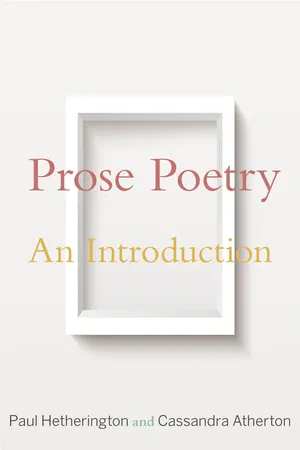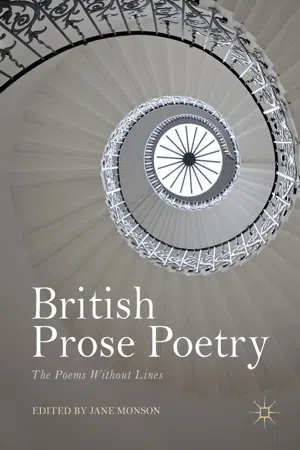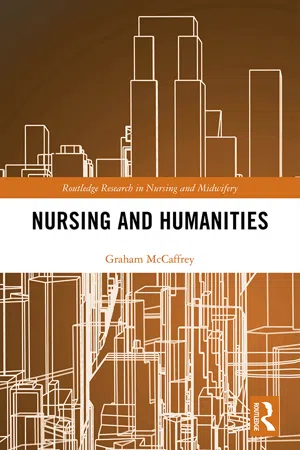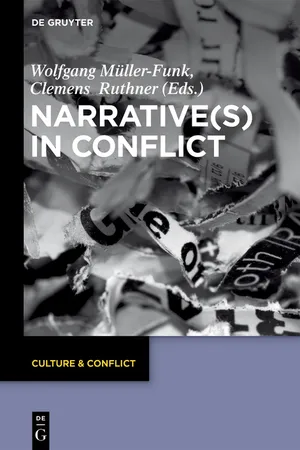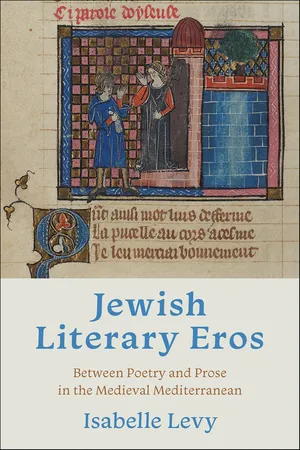Literature
Prose Poetry
Prose poetry is a hybrid literary form that combines the characteristics of prose and poetry. It lacks the line breaks and formal structure of traditional poetry, but still incorporates poetic elements such as heightened imagery, emotional intensity, and rhythmic language. Prose poetry allows for a more fluid and narrative style while maintaining the condensed and evocative nature of poetry.
Written by Perlego with AI-assistance
5 Key excerpts on "Prose Poetry"
- eBook - ePub
Prose Poetry
An Introduction
- Paul Hetherington, Cassandra Atherton(Authors)
- 2020(Publication Date)
- Princeton University Press(Publisher)
Prose Poetry may be conceived of as a new form of poetry to sit aside the forms of traditional lyric, narrative, and epic poetry. It may be viewed as a contemporary development of the possibilities of the poetic fragment, so beloved of the Romantic writers and so well suited to expressing meaning in a world where the grand narratives of the nineteenth century have long since been in disrepair. As the use of the prose mode in poetry challenges our understanding of literary forms and genres, it signals nothing less than that the main literary forms privileged in recent centuries—the novel, short fiction, lineated lyric poetry, and drama—may no longer confidently be said to constitute or describe the structures of contemporary “literature.”This is not a matter of agreeing with Maurice Blanchot that “[o]nly the book matters, such as it is, far from genres, outside of categories—prose, poetry, novel, testimony—under which it refuses to be classed.”91 Perhaps more crucially, an apparently undecidable literary form such as the prose poem opens up discussions about what the basis of poetry may be. If there are no firm zones of exclusion separating “poetry” and “prose,” then the more important distinction is between what is poetic (whether it occurs in poetry or prose) and what is prosaic (whether it occurs in prose or poetry). Christopher Prendergast writes, “part of the lesson of Rimbaud’s way with the prose poem or Laforgue’s experiments with verse libre is the blurring of the poetic/prosaic distinction.”92 - eBook - ePub
British Prose Poetry
The Poems Without Lines
- Jane Monson, Jane Monson(Authors)
- 2018(Publication Date)
- Palgrave Macmillan(Publisher)
6 So, ‘poetry’ in prose implies writing in prose form that incorporates the qualities of poetry: ‘direct language’ with ‘arrest[ing]’ images (Hulme); a dynamic, energized and relational take on the ‘world’ (Binyon).Of course, these were not the only re-definitions. Another way to understand differences among definitions is to separate the camps redefining ‘poetry’ according to the other art form that would serve as model: music (emphasis on rhythm, metricality, recalling Pater’s ‘All art constantly aspires towards the condition of music’ from The School of Giorgione ) or painting (emphasis on image and picture). Undoubtedly, such a division risks oversimplification. After all, even Ezra Pound ’s ‘A Few Don’ts by an Imagiste’ in Poetry (March 1913) addresses both image and rhythm, or, as F.S. Flint summarizes in the essay that precedes Pound’s in the volume: ‘Direct treatment of the “thing,” whether subjective or objective’, and ‘As regarding rhythm: to compose in sequence of the musical phrase, not in sequence of a metronome.’7 But, for some practitioners and critics, the musicality of poetic prose was definitional as opposed to an unmediated presentation of modern life. The American poet Amy Lowell ’s ‘polyphonic prose’ is a case in point. In ‘Miss Lowell’s Discovery: Polyphonic Prose’, John Gould Fletcher praises the ‘orchestral quality’ of her work, concluding that ‘it seems fitting that a new name should be given to these poems of hers, which, printed as prose, or as prose and verse interspersed, display all the colors of the chromatic palette.’8 Other critics were less convinced; Harriet Monroe, in reviewing the second Imagist collection, Some Imagist Poets —An Anthology , remarks that ‘Miss Lowell’s “polyphonic prose” in The Bombardment remains for me scientific and artificial, an interesting experiment rather than a new poetic form.’9 Lowell herself attempts distinctions, noting that ‘it is the fashion today to call everything which is without metre vers libre .’ She answers any confusion of verse and prose (of which Fletcher’s remark is an instance) with such a metrical approach, mapping a spectrum of rhythmic distinctions with ‘pure prose and pure poetry’ as the extremes, and ‘metrical prose’ and ‘vers libre’ as ‘steps’ in between.10 In the end, her divisions are at best tendencies: ‘Now as prose is a long curve with very little return, and poetry is a much shorter curve with a very sharp return; so metrical prose may be considered as a slightly more curved line than is usual in prose, with a return beginning to be felt, and vers libre as curving still more markedly, and the return becoming pronounced.’11 T.S. Eliot, in ‘The Borderline of Prose’, takes a similar tack in criticizing Richard Aldington ’s prose poems as failures in that they incorporate both prose and verse rhythms. Eliot quotes a passage from a prose poem by Aldington, then critiques the opening phrases: ‘For my sake Eos, in a cloudless sky, gliding from the many-isled sea, must be more tender and more thrilling.’ Eliot objects to the difference between the verse rhythms of ‘For my sake Eos, in a cloudless sky, gliding from the many-isled sea’ and the prose of ‘must be more tender and more thrilling.’ Eliot’s distinctions are even less defined than Lowell’s; he simply labels what are prose rhythms and what are verse to his ear.12 - eBook - ePub
- Graham McCaffrey(Author)
- 2020(Publication Date)
- Routledge(Publisher)
7 Prose and poetry in nursingCreative writing lives within the ecology of nursing knowledge: writing by nurses or about nurses; writing aimed at nurses, or communicating with a wider public, explaining, describing, evoking nurses’ experiences, and giving insights into what it is like to be a nurse. Creative writing can carry emotional weight that is part of life among working with people undergoing times of vulnerability, sickness, dying, fear, relief, restoration, even joy – or boredom, nagging uncertainty, and pain dragging through every day. Creative writing restores the emotional weight that is conscientiously trimmed from conventional research reporting, that is treated as merely subjective, peripheral, and confounding next to the cool clarity of the numbers, or even of carefully cropped statements, units of meaning, arranged into tidy themes.Human beings compulsively tell each other stories of how this was and how that went and why things turned out that way; we meet each other in stories, we bind our communities, sometimes heal, sometime wield them as a weapon against outsiders – but all that is to show that they are potent and we are caught up with stories as we are caught up with language. At times, statistics are just the thing to pull apart a badly made story, and at times a story is the best way of injecting life back into statistics.Creative writing includes numerous forms, each with its own demands and its own way of bringing aspects of life into the light. In this chapter I discuss forms, for what they can communicate about nursing, and reveal about different parts of nursing life. I contrast the broad genres of prose and poetry, where prose follows conventional rules of grammar and syntax, building by sentences and paragraphs into larger units of meaning, and poetry is made up of smaller phases, which could be parts of a much larger whole, that are formed by sound and rhythm as well as meaning. Another distinction in how different forms serve different purposes and achieve different effects is between narrative and lyric. Narrative points to the function, either in prose or poetry, of storytelling that gets from A to B, if not necessarily always in a straight line. Lyric, which is often conflated with poetry, may have a narrative thread but does not depend on it, and often aims to illuminate moments of intense experience. In the latter parts of the chapter, I discuss the place of lyric in relation to nursing using the example of a short but potent poem. - eBook - ePub
- Wolfgang Müller-Funk, Clemens Ruthner, Wolfgang Müller-Funk, Clemens Ruthner(Authors)
- 2017(Publication Date)
- De Gruyter(Publisher)
The need to differentiate, quite apart from the issue of their distinct traditions, derives from the way in which both deal with this very conflict between the sublime and the ordinary, the lyrical and the profane. Whilst the long poem is more closely related to the ballad, the poem in prose contains, at times, poetological elements in that it suggests self-reflection tinged with sensual immediacy. Its intellectual and sensual qualities are, however, rarely at ease and more often at odds with each other. The long poem in a modern sense of the word can be traced back to Walt Whitman (Leaves of Grass, first published in 1855) and, in its balladesque form, to Alfred Tennyson (1809–92). Its development is connected with names like William Carlos Williams (1883–1963), Charles Olson (1910 –70), Allen Ginsberg (1926–97), W.G. Sebald (After Nature, 1986) and Paulus Böhmer (in particular Kaddish, 2002). 26 The prose poem owes a great deal to the early symbolists, Charles Baudelaire (1821–67) in particular, but also – in a more realist vein – Ivan Turgenev (1818–83), before it gained exemplary significance in Rimbaud’s contribution to the genre. II In his autobiographical writings, Franz Grillparzer (1791–1872) suggested that he emerged as a poet and dramatist from his early attempts in writing poetic prose (Pörnbacher 1970: 9). His teachers told him he had no ear for writing in metric structure and therefore he seemed to have fused his inner musical sense with prose. It appears that he perceived an aesthetic conflict between verse and prose and the need to redeem it. With Georg Trakl (1887–1914), the prose poem emerged from his writing of verses. His poems in prose, however, offer a specific form of narration portrayed as intrinsic conflicts that generated haunting metaphors - eBook - ePub
Sephardi and Mizrahi Studies
Between Poetry and Prose in the Medieval Mediterranean
- Isabelle Levy(Author)
- 2022(Publication Date)
- Indiana University Press(Publisher)
and thus the poor book would be torn up into rags. As it is, you must take all or nothing.” 109 He is more intent on defining all possible categories of composition than on judging their respective merits. For instance, he offers a straightforward definition of prose—“pithy and elegant discourse, not in meter but divided by regular rhythms of clausulae”—just as he does for the other compositional forms. 110 Unlike the other critics, Matthew of Vendôme does not address the status of poetry in his Ars versificatoria but instead focuses all of his attention on poetic composition. The earliest vernacular prose treatises on the arts of poetry do not address the relative merits of prose and poetry at all; rather, these treatises outline ideal poetic composition and do not acknowledge the reality that they are unprecedented works of prose, as Elizabeth Wilson Poe explains: “the vidas, razos, and Old Provencal manuals of poetic composition. . . operate by extracting words from their original musical context and reassembling them into unsung, unmetered prose.” 111 The prose is clearly a vessel for conveying aims of poetic composition rather than a competing mode of literary expression. In his early thirteenth-century Razos de trobar, Ramon Vidal de Besalú does not address the topic of prose, nor does he incorporate any principles pertaining to prose into his discussion of how one should compose “un cantar o un romans.” 112 In his prose treatise, he demonstrates steadfast approval of Occitan lyric without any mention of prose: “And all the good and evil things of the world are made memorable by the troubadours. And you won’t find a well-expressed or badly expressed idea that, once a troubadour has set it to rhyme, will not be remembered forever
Index pages curate the most relevant extracts from our library of academic textbooks. They’ve been created using an in-house natural language model (NLM), each adding context and meaning to key research topics.
Explore more topic indexes
Explore more topic indexes
1 of 6
Explore more topic indexes
1 of 4
